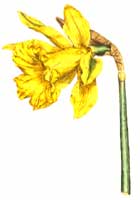First, I carried a notepad with me and when I had free time, I sketched out seam treatments. For example, I would start with a basic stitch like a herringbone, add some detached chain stitches, some straight stitches, maybe a French knot or a seed bead and then I had my design.
Next, when stitching, I used a small ruler (6") and a chalk pencil, not a wax pencil! This is very important. The chalk will rub off. The wax may not. I like Clover Brand. You can get them in a package with 3 colors and a sharpener.
With the ruler and pencil, I would draw little even lines and I would use this as my guide to stitch and keep them even. My Friend Marci likes Tiger Tape to do her precise stitches. It works well too. Sometimes, I would draw a light line parallel to the seam so that I could stay on a straight line.
For designing special stitches like an animal, I would draw a little picture and try to figure out how to convert it into stitches. For example, with the little birds, it is mostly just a series of straight stitches and a French knot for the eye.
 I use a lot of cotton thread because I have rough hands and silk and rayon frustrate me because I get it snagged on my hands. I use a lot of perle cotton. I also am not afraid of using one strand of cotton floss to accent.
I use a lot of cotton thread because I have rough hands and silk and rayon frustrate me because I get it snagged on my hands. I use a lot of perle cotton. I also am not afraid of using one strand of cotton floss to accent.
For my favorite threads, I love bright colors. I feel that if I am going to spend the time stitching, I want them to show.
I have a new favorite variegated hand-dyed thread but it can be expensive. The secret is finding a friend or two to share it with. The perle cotton hanks are large. I like sizes # 12 and # 8. It is made by Artfabrik, sold only online or at larger quilt shows like Houston and Chicago. She now has a really nice floss, too. The variegations are great so it shows up after stitching, which gives more texture to the stitching.
I also like Wildflowers by Caron. It is a perle cotton size #8. Below is Wildflowers thread and Artfabrik sizes #8, # 12, and cotton floss. I discovered Presencia Finca Perle Cotton Thread a few years ago and really liked it. It comes in a lot of great colors and sizes. My favorite sizes are #12 and #16, which is fairly fine but this allows for the complexity of the stitches. It is also reasonably priced and I have found several quilt shops that carry it. I would not recommend their variegated perle cotton because the variegations are too far apart so when you use it, it doesn't change variegation quickly enough so it doesn't look variegated.
I discovered Presencia Finca Perle Cotton Thread a few years ago and really liked it. It comes in a lot of great colors and sizes. My favorite sizes are #12 and #16, which is fairly fine but this allows for the complexity of the stitches. It is also reasonably priced and I have found several quilt shops that carry it. I would not recommend their variegated perle cotton because the variegations are too far apart so when you use it, it doesn't change variegation quickly enough so it doesn't look variegated.
DMC has some newer cotton floss that I like really well called Color Variations.
Anchor has a few colors of variegated floss and perle cotton.
Below is DMC perle cotton size #5 and Color Variations cotton floss, Presencia Finca perle cotton size #16, and Anchor variegated floss. You can see that you don't have to have silk thread to get really great thread so if you have rough hands like I do, there are options.
You can see that you don't have to have silk thread to get really great thread so if you have rough hands like I do, there are options.





 Many of the stitches are taken from antique CQ's that I have seen on Ebay over the years.
Many of the stitches are taken from antique CQ's that I have seen on Ebay over the years.





























 Quilter Blogs & Store Search
Quilter Blogs & Store Search
